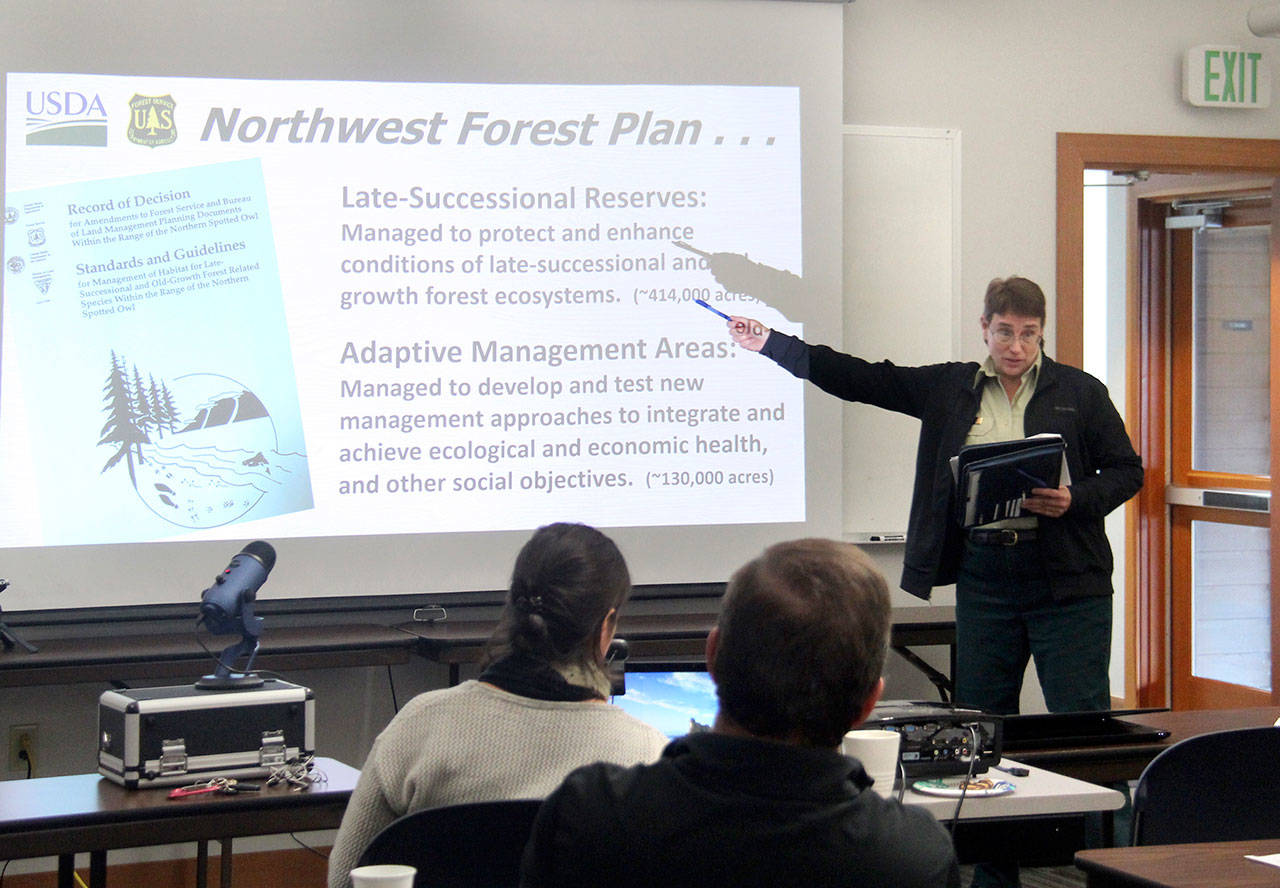FORKS — Almost four years since it was launched by U.S. Rep Derek Kilmer, D-Gig Harbor, and nearly two years since the last meeting in Forks, members of the Olympic Peninsula Forest Collaborative came to Forks to tell of accomplishments and to seek public input on future plans.
Members of the collaborative and non-voting members from the Olympic National Forest, Olympic Natural Resources Center (ONRC) and several other entities said Tuesday that the common goal is to increase timber harvest and aid the local economy while also protecting the forests.
Meeting facilitator Bernard Bormann, director of the ONRC, told the 25 people attending that his agency will be involved — per a mandate and funding from the state Legislature — with several graduate students who will create a 2018-19 Stakeholders Survey that seeks information on areas of interest and direction the public would like to see the collaborative take.
The collaborative will help provide stakeholder input in early project planning and increase public awareness as the projects collect data.
All information collected will be housed at ONRC.
“We will be assisting to help collect what is learned and develop a strategy to see if the collaborative is achieving goals within a framework,” Bormann said.
The collaborative was implemented through the Northwest Forest Plan and aims to develop and test new management approaches to integrate and achieve ecological and economic health as well as other economic objectives.
Reta Laford, Olympic National Forest supervisor said her agency’s current emphasis within the restoration framework will treat more acres and increase volume using congressional appropriations as well as timber sales that retain the funds created to use for North Olympic Peninsula projects.
“We want to do more and build relationships,” Laford said.
Paul Bialkowsky, timber manager for Olympic Peninsula Operations for Interfor and a collaborative member, said the group is working for a shared goal among industry, government, and environmentalists to increase timber harvest while maintaining forest and watershed quality.
“The stewardship sale revenue stays here,” Bialkowsky said. “Those dollars do not go to the federal treasury. They benefit projects here to be re-invested in other projects and recreation.
“There is still the normal bidding and sales but the stakeholders work together to develop the projects.”
Said Matt Comisky, Washington program manager for the American Forest Resource Council: “We are forming relationships and trust.”
Comisky told of the H to Z stewardship sale in the Sol Duc River watershed. It was the first pilot project of the Olympic Peninsula Forest Collaborative in the Pacific Ranger District of the Olympic National Forest.
The sale had two components: a thinning project and upland habitat enhancement to bring diversity to the plant understory and improve habitat for sensitive and endangered species.
The goal was to try different approaches to learn management practices that could be applied elsewhere in the national forest. The project was completed in September 2017 by Sierra Pacific Industries.
The harvest volume was 10,787 green tons and it generated $313,902 gross revenue. A total of $296,982 was generated for stewardship restoration projects, 1,000 seedlings were planted and interplanting of underrepresented species was completed as part of the project.
Jill Silver, collaborative member and executive director of the 10,000 Years Institute, described activities in several photos that showed plots of timber stands with trees marked, identified and inventoried. The plots are monitored at various stages of harvest.
“We will be looking at before and after thinning and compare side by side and hope to use drone and wildlife camera too to see what birds and animals visit the plots,” Bormann said.
“There is a social element to this, to provide an opportunity for the community to look and share their views, the community will play a vital role,” Bormann added.
“Ecosystem sustainability needs a community and environmental partnership, interaction is critical.
“Partnerships will need to be developed to help fund the cost of this research. Sustainability is discussed but we don’t monitor the results.”
Collaborative forest activities will also have non-treated areas that will be monitored and compared to area where harvesting activities take place.
Rod Fleck, Forks’ city attorney/planner, said it was great to see the collaborative back in Forks but it concerned him that the community had been left out of the plan.
“Community of place needs to be included. I don’t see Amanda Park, Forks or the tribes mentioned,” Fleck said.
Silver said: “We are getting to that point now.”
Fleck also suggested the collaborative open its membership to a broader mix of stakeholders.
Comisky said that the collaborative will continue to seek funding, look to incorporate local schools and perhaps Peninsula College to help with monitoring and seek input from the community and how they might want to participate.
________
Christi Baron is the editor of the Forks Forum, which is part of the Olympic Peninsula News Group, composed of Sound Publishing newspapers Peninsula Daily News, Sequim Gazette and Forks Forum. Reach her at cbaron@forksforum.com.

